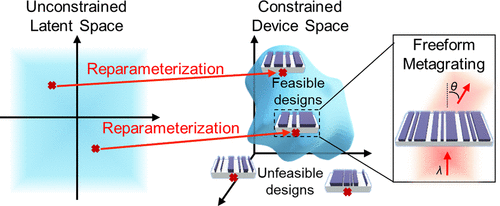当前位置:
X-MOL 学术
›
ACS Photonics
›
论文详情
Our official English website, www.x-mol.net, welcomes your feedback! (Note: you will need to create a separate account there.)
Design Space Reparameterization Enforces Hard Geometric Constraints in Inverse-Designed Nanophotonic Devices
ACS Photonics ( IF 7 ) Pub Date : 2020-10-26 , DOI: 10.1021/acsphotonics.0c01202 Mingkun Chen 1 , Jiaqi Jiang 1 , Jonathan A. Fan 1
ACS Photonics ( IF 7 ) Pub Date : 2020-10-26 , DOI: 10.1021/acsphotonics.0c01202 Mingkun Chen 1 , Jiaqi Jiang 1 , Jonathan A. Fan 1
Affiliation

|
Inverse design algorithms are the basis for realizing high-performance, freeform nanophotonic devices. Current methods to enforce geometric constraints, such as practical fabrication constraints, are heuristic and not robust. In this work, we show that hard geometric constraints can be imposed on inverse-designed devices by reparameterizing the design space itself. Instead of evaluating and modifying devices in the physical device space, candidate device layouts are defined in a constraint-free latent space and mathematically transformed to the physical device space, which robustly imposes geometric constraints. Modifications to the physical devices, specified by inverse design algorithms, are made to their latent space representations using backpropagation. As a proof-of-concept demonstration, we apply reparameterization to enforce strict minimum feature size constraints in local and global topology optimizers for metagratings. We anticipate that concepts in reparameterization will provide a general and meaningful platform to incorporate physics and physical constraints in any gradient-based optimizer, including machine learning-enabled global optimizers.
中文翻译:

设计空间的重新参数化在逆设计的纳米光子器件中加强了严格的几何约束
反设计算法是实现高性能,自由形式的纳米光子器件的基础。当前用于实施几何约束(例如实际制造约束)的方法是试探性的,而不是可靠的。在这项工作中,我们表明可以通过重新参数化设计空间本身,对逆向设计的设备施加严格的几何约束。代替评估和修改物理设备空间中的设备,可以在无约束的潜在空间中定义候选设备的布局,并在数学上转换为物理设备空间,从而强加了几何约束。由逆设计算法指定的对物理设备的修改是使用反向传播对其潜在空间表示进行的。作为概念验证的演示,我们应用重新参数化在本地和全局拓扑优化器中对中继进行严格的最小特征尺寸约束。我们预计,重新参数化的概念将提供一个通用且有意义的平台,以将物理和物理约束纳入任何基于梯度的优化器中,包括启用了机器学习的全局优化器。
更新日期:2020-11-18
中文翻译:

设计空间的重新参数化在逆设计的纳米光子器件中加强了严格的几何约束
反设计算法是实现高性能,自由形式的纳米光子器件的基础。当前用于实施几何约束(例如实际制造约束)的方法是试探性的,而不是可靠的。在这项工作中,我们表明可以通过重新参数化设计空间本身,对逆向设计的设备施加严格的几何约束。代替评估和修改物理设备空间中的设备,可以在无约束的潜在空间中定义候选设备的布局,并在数学上转换为物理设备空间,从而强加了几何约束。由逆设计算法指定的对物理设备的修改是使用反向传播对其潜在空间表示进行的。作为概念验证的演示,我们应用重新参数化在本地和全局拓扑优化器中对中继进行严格的最小特征尺寸约束。我们预计,重新参数化的概念将提供一个通用且有意义的平台,以将物理和物理约束纳入任何基于梯度的优化器中,包括启用了机器学习的全局优化器。



























 京公网安备 11010802027423号
京公网安备 11010802027423号